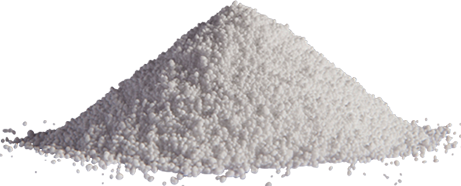POTASSIUM CARBONATE
Overview:
Potassium carbonate is also known as potash, pearl ash, salt of tartar, carbonate of potash, and salt of wormwood. It is a white, translucent, odorless, granular or crystalline material that tends to absorb water from the air. It is a mild alkali that has been used since recorded history in the making of soap and glass. Historically, it was derived from the boiled ashes of hardwood trees (hence the term "potash.")
Today, potassium carbonate is prepared for commercial use through the electrolysis of potassium chloride. An estimated 7 million metric tons of potassium carbonate is produced annually in the United States. While still used in the production of glass and detergents, potassium carbonate is also used in the production of fertilizers, photographic chemicals, pharmaceuticals, food products, cement and textiles.1
Characteristics and Challenges:
Most grades of potassium carbonate have an average bulk density of 20 lb/cu ft 2. Some grades of potassium carbonate carry an HMIS Health rating of 2, meaning hazardous in case of eye contact (irritant), of inhalation (lung irritant) and slightly hazardous in case of skin contact (irritant, sensitizer).3
Typically crystalline in form, potassium carbonate may also be micronized. Potassium carbonate is hygroscopic, meaning that moisture, humidity and temperature may impact its flow. In granular form, potassium carbonate can be abrasive, so the equipment used to convey it should be able to withstand any potential effects from prolonged contact. If micronized, potassium carbonate can agglomerate in the processing system. Consultation on your application for potassium carbonate with an experienced material handling equipment provider is recommended.
If the potassium carbonate is packaged in smaller bags, a bag-breaking station with a dust hood and filter cartridges is likely sufficient to support the manual unloading of the material. A pneumatic pulse can be used to clean the filters and return the trapped potassium carbonate back into the receiving hopper.
As the potassium carbonate fills the receiving hopper, the air inside the vessel is forced out. If this air passes through a static filter, the possibility of airborne potassium carbonate dust particles escaping into the surrounding atmosphere is increased, especially if the material is micronized. A dust collector mounted on the discharger frame will contain the potassium carbonate dust inside the conveyance system. This not only lowers the amount of housekeeping efforts necessary, but the collector can also reduce product waste if it is equipped with a reverse pulse jet which pneumatically cleans the filter media, returning the collected potassium carbonate back to the receiving hopper.
The geometry of the feed hoppers is another important aspect in handling potassium carbonate. To guarantee flow within the hopper, there may be a need to incorporate devices such as vibrators

or mechanical agitators to promote flow. A hopper screen above the receiving vessel will help protect the operators if the potassium carbonate is being dumped manually into a hopper that is equipped with agitating devices.
If the potassium carbonate is being pneumatically conveyed into a processing system, the blower used to move potassium carbonate through the air line must be sized to meet the demands of system. Potassium carbonate tends to absorb moisture from the air and may agglomerate, so additional devices may be required to reduce the humidity levels or draw moisture from the potassium carbonate prior to its entrance into the conveyor.
Due to potassium carbonate's crystalline form and its free-flowing nature, a round screw design is commonly used for flexible screw conveying.
Should your potassium carbonate application feature the loading of micronized potassium carbonate into bulk bags, the capacity of the bags can be maximized by use of vibratory densification decks that de-aerate the potassium carbonate as it fills the bags, while the use of load cells will ensure that the bags are consistently filled to the desired weight.
Flexicon Applications:
A Flexicon system featuring a bulk bag unloader and flexible screw conveyor improved safety and processing of fertilizers for a UK fertilizer manufacturer.
Flexicon's dust suppression and collection systems ensure proper containment of potassium carbonate throughout the conveyance process.
Consultation with a Flexicon specialist will help you decide if a flexible screw or pneumatic solution best fits your potassium carbonate application.
Flexicon's expert design and engineering staff will weigh each parameter and recommend the best solution for you. Upon request, Flexicon's test lab will simulate your potassium carbonate handling functions before the system is installed in your plant.
Flexicon's product line of advanced flow promotion conveyors, high flow hoppers, deaeration/densification decks and a host of other components and accessories are proven performers that promote flow while reducing degradation, dusting and/or the separation of blends comprised of disparate particles.
Related Articles on Potassium Carbonate:
1 USGS Potash, 2011 Report
2 Source: Powder and Bulk. Com - Bulk Density Chart
3 Material Safety Data Sheet, Potassium Carbonate
Sources: Where noted. All other information courtesy of Flexicon Corporation.